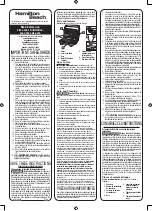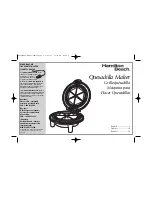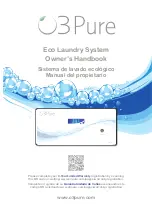
28 / 45
The jars which are fully immersed are sealed, that is why no water gets to them.
– Heating of the full volume of the pot may take up to 1.5 hours, it is therefore more efficient and
faster to preserve “in steam”. Pour approx. 5-10 cm of water into the pot, this volume will heat
up faster and the steam created will preserve with up to 60 % energy savings.
– The temperature of water poured into the container should be approximately the same as the
temperature inside of the jars.
– Look up the temperature and time for preservation in your recipes, possibly other books about
preservation.
– Preserving starts only when the set temperature is reached.
– Take out the jars when the time needed for preservation is up.
– Store the preserved food in a cool, dark place.
– It is good to write the date of preservation and their contents on the jars.
PRESERVATION TABLE
Fruit
temperature
(
o
C)
Time
(min)
Vegetable
Temperature
(
o
C)
Time
(min)
currant
85
20
cauliflower
100
90
puree
90
30
bean pods
100
120
pears
90
30
thick beans
100
90
strawberries
75
25
peas
100
120
blueberries
85
25
pickled vegetable
90
30
raspberries
80
30
carrot (small)
100
90
cherries
80
30
carrot
100
90
mirabelle
90
30
turnip
100
90
peaches
90
30
pumpkins
90
30
apricots
90
30
brussels sprouts
100
120
rhubarb
100
30
asparagus
100
120
gooseberry
80
30
kale
100
120
plums
90
30
tomatoes
90
30
Meat
Temperature
(
o
C)
Time
(min)
roasted meat, pre-rosted
100
75
goulash
100
75
poultry, game, roast
100
75
schnitzel, chops, roast
100
75
smoked meat products
100
120
The times in the table are only approximate. The time before reaching the temperature is very
individual and depends on multiple factors. The times in the table apply from the point of reaching
the set temperature.
CLEANING AND MAINTENANCE
Never immerse the appliance in water! Turn the appliance off by unplugging it from the
outlet before any maintenance. Do not use coarse and abrasive cleaning agents (e.g. sharp
objects, peelers, chemical solvents, thinning agents, caustic agents for cleaning ovens
or other solvents)!
Wipe the outer surface with a damp cloth with soap. Rinse the container
from the inside and remove some possible sediments of limescale with a solution of citric acid
or vinegar (then let boil with clean water). You can take apart the release valve
A2
and clean
sep
arately. Nev
er dry the plastic die-cast over a heat source (e.g.
stove, el./gas cooker
).
















































